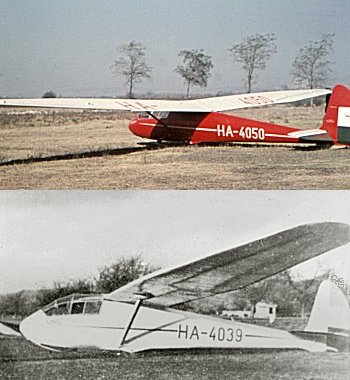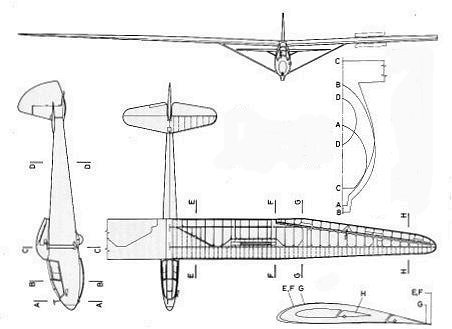HUNGARIAN
GLIDERS
1933-2000
| Type designation: |
R-12 |
| Name: |
Kevély |
| Designer: |
Ernő RUBIK |
| Class: |
performance |
| General arrangement: |
High strutted wing, monocoque fuselage, fixed wheel, traditional tail unit |
| Crew: |
1 |
| First flight: |
April, 1941 |
| Manufacturer: |
Aero Ever Ltd. |
| Number of built: |
cca. 50 |

Short history:
The R-12 Kevély had been appeared at the same time as the R-11b Cimbora. According to the instruction system of the National Aviation Foundation pilots were to fly R-09 Pilis training glider after finishing their basic instruction on standardized basic school gliders of R-07a Tücsök and R-07b Vöcsök. However to learn the tricks in performance flying called for a glider having better performance than the Pilis. In the fall of 1939 the Hungarian Aero Association ordered a single seater performance glider suitable for cloud flying with robust structure at the Aero Ever Ltd. in Esztergom.
The R-12 Kevély was designed by Ernő Rubik, who - to serve novice soaring pilots - developed a robust structure even loosing a bit of performance in the process. The prototype first flew at April, 1941.
She was a stable glider with very pleasant handling in thermals. She climbed steadily with 55-60 km/h flying speed in 15-16 sec. circles. If her pilots lost control in cloud, it was easy to initiate a spin. She rotated in spin slowly and did not exceed the speed of 55 km/h. Moving the controls to neutral positions, the glider assumed normal circling in the same direction as the rotation, loosing only 150 m during this manoeuvre. This feature made the practice of cloud flying safe. Pilots one after another gained new altitude records in 1943 with this glider, . In 1943 János Stolte achieved a new Hungarian height gaining record with 4083 m climb, then Béla Bollman breaked it with 4273 m, then Pál Vojnits breaked it again with 5053 m. A series of cross country flights over 100 and 200 km distances, and a 312 km flight proved the performance capabilities of this glider.
25 R-12 gliders were built by Aero Ever, and in 1944 another 8 by the Aircraft Factory of Transylvania. The glider were also built by workshops of aero clubs. Altogether cca. 50 R-12 Kevély were built before the end of WWII. The last Kevély were scrapped in 1951.
Structure: -
Wing:
The wings of the high-winged, all-wooden glider were strutted and had a single main spar. The wings were covered in front of the main spar by plywood, behind it with fabric. The ends of the struts were shaped as threads making possible to change of the wings' dihedral a bit. The big Göppingen type airbrakes helped pilots in cloud flying as well as landing the glider. The wings had fairly high degree of aerodynamic washout causing good spin characteristics, however decreasing the gliding performance at higher flying speeds.
Fuselage:
The plywood covered semi-monocoque fuselage had a well streamlined canopy featuring good visibility. Two big sliding windows on both side of the canopy give good visibility even in icing conditions. The instrument panel was big enough to accommodate all instruments necessary for cloud flying. The pedals of rudder control were adjustable in flight. The landing gear consisted of a fixed wheel with brakes, as well as a nose and a small aft skid.
Tail unit:
The tail unit had traditional arrangement with struts bracing the horizontal stabilizer. The stabilizers were covered by plywood, the control surfaces with fabric.
.jpg)

| Dimensions: |
| Wing: |
| Span, m: |
18 |
| Area, m2: |
20,7 |
| Aspect ratio: |
15,64 |
| Chord (root), m: |
1,2 |
| Chord (tip), m: |
0,6 |
| Airfoil (root), m: |
Gö 549 |
| Airfoil (mid-span), m: |
Gö 549 |
| Airfoil (tip), m: |
Gö 676 |
| Dihedral, degree: |
2 |
| Sweep, degree: |
0 |
| Washout: |
Aerodynamic |
| Aileron: |
| Span, m: |
5,4 |
| Mean chord, m: |
0,6 |
| Total area, m2: |
3,54 |
| Balancing: |
Aerodynamic |
| Airbrakes: |
| Type: |
Göppingen |
| Position (upside/downside): |
u/d |
| Total area, m2: |
0,46 |
| Position, % of chord: |
40 |
| Horizontal stabilizer: |
| Span, m: |
3,2 |
| Area, m2: |
2,3 |
| Elevator: |
| Span, m: |
3,2 |
| Area, m2: |
0,86 |
| Airfoil: |
symmetric |
| Balancing: |
None |
| Trim: |
Yes |
| Vertical stabilizer and rudder: |
| Total area, m2: |
1,03 |
| Rudder area, m2: |
1,43 |
| Balancing: |
Aerodynamic |
| Fuselage: |
| Length, m: |
7,78 |
| Width, m: |
0,58 |
| Height: |
1,04 |
| Cross section, m2: |
0,54 |
| Landing gear: |
| Type: |
fixed |
| Wheel diameter, m: |
0,42 |
| Masses: |
| Wing, kg: |
160 |
| Fuselage, kg: |
88 |
| Tail unit, kg: |
16 |
| Empty glider, kg: |
264 |
| Gross, kg: |
358 |
| Ballast, kg: |
None |
| Wing loading, kg/m2: |
17,3 |
| Speeds: |
| VNE, km/h: |
210 |
| Max. speed with open airbrakes, km/h: |
210 |
| Max. aerotow speed, km/h: |
100 |
| Max. winch speed, km/h: |
90 |
| Max. speed in rough air, km/h: |
100 |
| Stall speed, km/h: |
54 |
| Performance: |
| Min. sink, m/s (at gliding speed, km/h): |
0,68/60 |
| Best L/D (at gliding speed, km/h): |
24/65 |
| Start methods: |
Bungee, Winch, Aerotow |

Origin of data and 3-view drawing:
Jereb Gábor: Magyar vitorlázó repülőgépek, Műszaki Könyvkiadó, 1988, Budapest
(Gábor JEREB: Hungarian Gliders, Technical Publishing House, 1988, Budapest)
Gábor FEKECS E-mail: fekecs.gabor@t-online.hu

.jpg)
